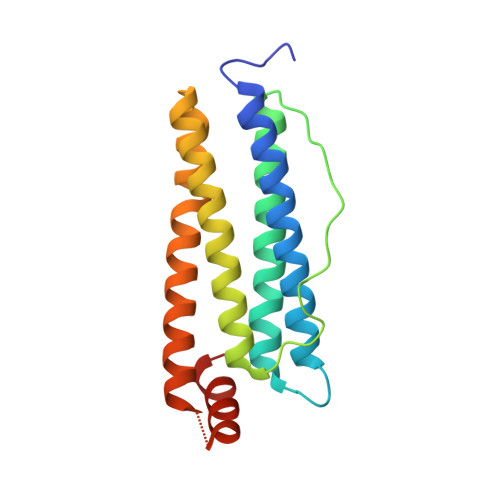Structural basis for high-affinity volatile anesthetic binding in a natural 4-helix bundle protein.
Liu, R., Loll, P.J., Eckenhoff, R.G.(2005) FASEB J 19: 567-576
- PubMed: 15791007
- DOI: https://doi.org/10.1096/fj.04-3171com
- Primary Citation of Related Structures:
1XZ1, 1XZ3 - PubMed Abstract:
Physiologic sites for inhaled anesthetics are presumed to be cavities within transmembrane 4-alpha-helix bundles of neurotransmitter receptors, but confirmation of binding and structural detail of such sites remains elusive. To provide such detail, we screened soluble proteins containing this structural motif, and found only one that exhibited evidence of strong anesthetic binding. Ferritin is a 24-mer of 4-alpha-helix bundles; both halothane and isoflurane bind with K(A) values of approximately 10(5) M(-1), higher than any previously reported inhaled anesthetic-protein interaction. The crystal structures of the halothane/apoferritin and isoflurane/apoferritin complexes were determined at 1.75 A resolution, revealing a common anesthetic binding pocket within an interhelical dimerization interface. The high affinity is explained by several weak polar contacts and an optimal host/guest packing relationship. Neither the acidic protons nor ether oxygen of the anesthetics contribute to the binding interaction. Compared with unliganded apoferritin, the anesthetic produced no detectable alteration of structure or B factors. The remarkably high affinity of the anesthetic/apoferritin complex implies greater selectivity of protein sites than previously thought, and suggests that direct protein actions may underlie effects at lower than surgical levels of anesthetic, including loss of awareness.
- Department of Anesthesia, University of Pennsylvania, Philadelphia, Pennsylvania, USA.
Organizational Affiliation:


















